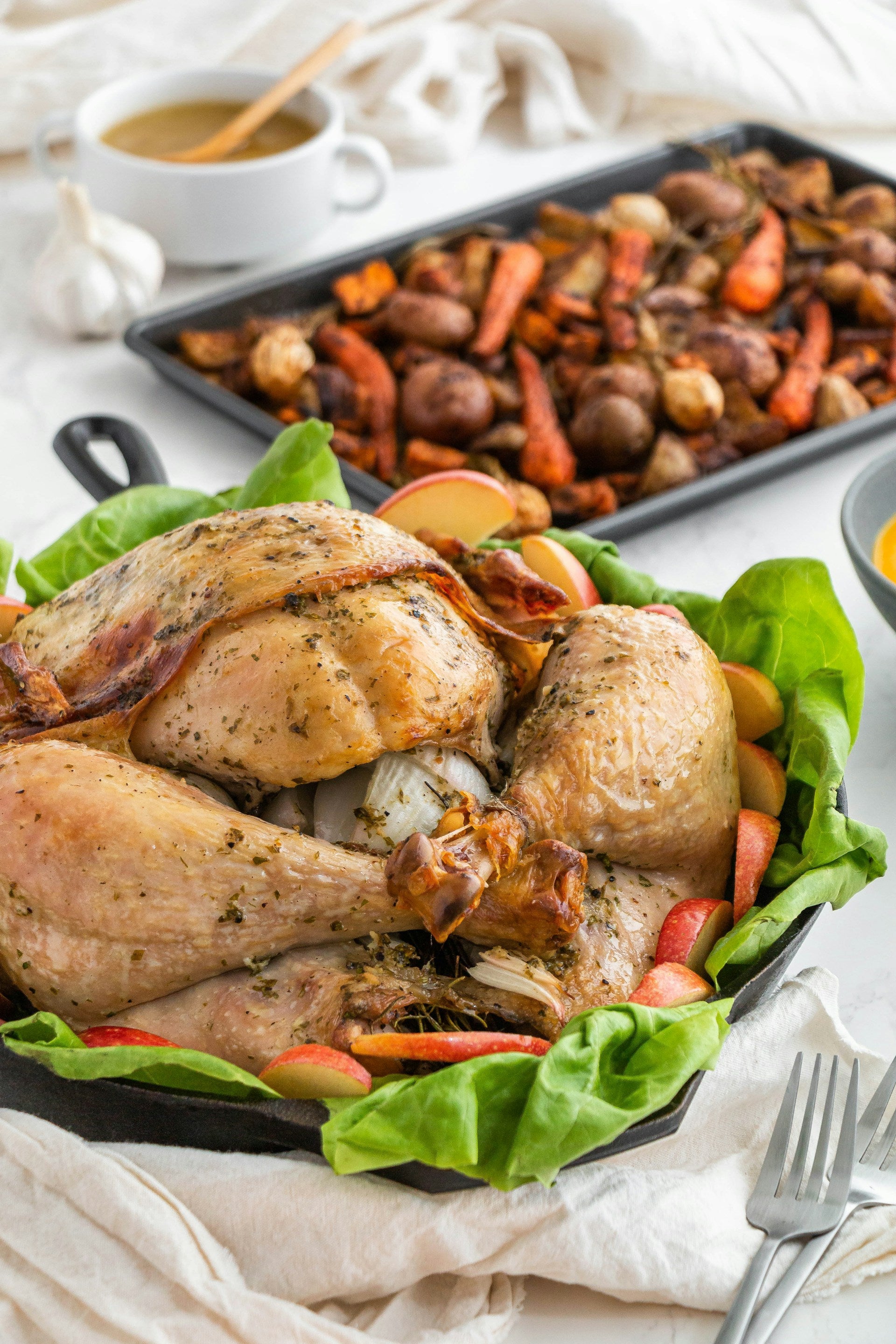The Importance of Proper Refrigeration
Refrigeration plays a pivotal role in food safety and preservation. By understanding how temperature affects food and why proper storage is crucial, you can ensure that your groceries, especially perishable items like turkey, retain their quality and nutritional value for as long as possible.
Understanding the Impact of Temperature on Food Storage
Temperature regulation is the cornerstone of food preservation. The fridge operates by slowing down the growth of bacteria, which is most active between 40°F and 140°F (4°C to 60°C), known as the 'Danger Zone'. Maintaining your refrigerator below this threshold is imperative to prolong the shelf life of foods like turkey.
| Temperature Range | Bacterial Growth Rate |
|---|---|
| Below 40°F (4°C) | Slow |
| 40°F to 140°F (4°C to 60°C) | Rapid |
To learn more about the importance of maintaining optimal temperatures in your fridge and how it prevents bacterial growth, you might want to read about cracking the code discovering the amp usage of refrigerators.
Why Proper Storage Matters for Prolonging Food Life
Proper storage in the refrigerator doesn’t just slow bacterial growth; it also helps maintain the quality of your food. When stored correctly, turkey can retain its flavor, texture, and nutritional value. This is especially relevant when you have leftovers or have bought in bulk and need to extend and conquer maximizing chicken's shelf life in your fridge.
Storing turkey properly involves more than just setting the right temperature. You need to consider factors such as wrapping the turkey to prevent cross-contamination, placing it on the right shelf to avoid drippings on other foods, and ensuring it's not pushed to the back of the fridge where cold spots might freeze parts of it unintentionally.
By taking these steps, you're not just prolonging the turkey's life in the fridge; you're also ensuring that every meal you prepare with it is safe and delicious. For those interested in optimizing their kitchen space while maintaining food quality, maximize space with style best narrow side by side refrigerators may provide some stylish and practical solutions.
Storing Turkey in the Fridge
When it comes to preserving poultry, particularly turkey, refrigeration is a pivotal step in extending its shelf life and ensuring its safety for consumption. Proper preparation and placement within the fridge can significantly affect the duration for which your turkey remains fresh.
Preparing the Turkey for Refrigeration
Before placing your turkey in the fridge, it's crucial to handle it correctly to prevent bacterial growth. If your turkey is cooked, ensure it's not left at room temperature for more than 2 hours. Here are steps to prep your turkey for the fridge:
- Allow the turkey to cool slightly before refrigerating to prevent raising the refrigerator's internal temperature.
- Divide larger portions into smaller pieces to facilitate uniform cooling.
- Place the turkey in airtight containers or wrap it tightly in plastic wrap or aluminum foil to prevent air exposure.
- Label the containers with the date to keep track of how long the turkey has been stored.
Optimal Placement in the Fridge
The location where you store your turkey in the fridge can impact its longevity. Follow these guidelines for optimal placement:
- Upper Shelves: Store ready-to-eat items or leftovers like cooked turkey on the upper shelves where the temperature is most consistent.
- Lower Shelves: Raw turkey should be placed on the lowest shelf to prevent any juices from contaminating other foods.
- Away from the Door: Avoid storing turkey in the door shelves as the temperature there fluctuates with frequent opening.
By adhering to these storage principles, you can maximize your turkey's freshness and enjoy its flavors for a longer period. If you're considering the best refrigerator options to accommodate your needs, explore articles such as maximize space with style best narrow side by side refrigerators and unlocking spacious cooling with 33 inch french door fridge options for insights on fridge features and organization.
Remember, proper preparation and strategic placement are key components in the power of preservation, prolonging the turkey's life in your fridge. For more tips on preserving different types of food, check out our articles on extend and conquer maximizing chickens shelf life in your fridge and bread lasting power unraveling the time bread can survive in the fridge.
Utilizing Refrigerator Features
Making the best use of your refrigerator's features can significantly enhance the shelf life of your foods, including turkey. Let's focus on how to properly adjust temperature settings and use crisper drawers to prolong the freshness of your turkey.
Adjusting Temperature Settings
The USDA recommends keeping your refrigerator at or below 40°F (4°C) to safely store food, and this is especially true for perishables like turkey. To ensure that your refrigerator is at the optimum temperature for preservation, consider using an appliance thermometer to monitor the internal temperature.
| Fridge Zone | Recommended Temperature |
|---|---|
| Main Compartment | 35°F - 38°F |
| Crisper Drawers | 32°F - 35°F |
| Door Shelves | 40°F - 42°F |
Adjusting the temperature settings according to your refrigerator's specific features and load is essential. For instance, if your fridge is packed with items, it may require a colder setting to compensate for the reduced air circulation. Conversely, a lightly loaded fridge might not need to be set as cold. To learn more about optimizing your refrigerator's temperature and space, explore articles like maximize space with style best narrow side by side refrigerators and efficiency redefined unveiling the top 30 inch bottom freezer refrigerators.
Using Crisper Drawers Effectively
Crisper drawers are designed to maintain a slightly different humidity level than the main compartment of your refrigerator. These can be an ideal spot for storing turkey if you aim to maintain its freshness for a longer period.
When storing turkey in crisper drawers, ensure that you:
- Set the humidity level to low for cooked turkey, as excess moisture can expedite spoilage.
- Place raw turkey in a sealed container or wrap it tightly to prevent cross-contamination with fruits and vegetables.
- Avoid overcrowding the drawers to maintain proper air circulation.
To maximize the efficacy of crisper drawers, familiarize yourself with their specific design and functionality. Some refrigerators may have specialized crispers with adjustable humidity controls or other preservation technologies. For additional insights on refrigerator organization and features, consider reading unlocking spacious cooling with 33 inch french door fridge options or the ultimate kitchen essential choosing the ideal 30 refrigerator bottom freezer.
Properly utilizing your refrigerator's features can make a significant difference in the longevity of your stored turkey. By adjusting temperature settings and using crisper drawers effectively, you can harness the power of preservation to extend your turkey's life in the fridge.
Tips for Prolonging Turkey's Shelf Life
Ensuring your turkey remains fresh and safe to eat involves more than just placing it in the fridge. Proper packaging and rotation are key strategies to prolong its shelf life.
Properly Packaging the Turkey
To preserve your turkey's freshness, proper packaging is paramount. Use airtight containers or wrap the turkey in aluminum foil or plastic wrap to protect it from air and moisture, which can accelerate spoilage. If you're storing cooked turkey, allow it to cool to room temperature for no more than two hours before refrigerating to prevent bacterial growth.
For added convenience and to minimize the risk of cross-contamination, consider portioning the turkey into the amounts you'll use for future meals. This way, you only need to unpack the portion you intend to use, keeping the rest securely sealed.
Here's a simple table to help you track how long your turkey can stay fresh in the fridge:
| State of Turkey | Refrigeration Time (days) |
|---|---|
| Raw, whole | 1-2 |
| Raw, parts (breasts, thighs, wings) | 1-2 |
| Cooked, whole | 3-4 |
| Cooked, leftovers | 3-4 |
For more detailed guidelines on storing different types of meats, check out our comprehensive guide on the meat challenge how to keep your fridge stocked and safe.
Rotating the Turkey
Regularly rotating the turkey in your fridge ensures that it stays at the optimal temperature throughout. Place newer items at the back and move older items to the front, prompting you to use them sooner. This practice, known as the First-In, First-Out (FIFO) method, is a cornerstone of effective food storage.
Additionally, consider the location within your fridge. The back of the lower shelves is typically the coldest area, making it ideal for raw turkey storage. Cooked turkey should be stored on the upper shelves, where the temperature is more consistent and there's a lower risk of raw juices contaminating other foods.
By combining these techniques with the insights from articles such as maximize space with style best narrow side by side refrigerators and unlocking spacious cooling with 33 inch french door fridge options, you can not only prolong your turkey's shelf life but also manage your fridge space more efficiently.
Checking for Freshness
When it comes to preserving turkey in the fridge, ensuring its freshness is paramount. Turkey, like any other perishable food, can spoil over time. To prevent foodborne illness and maintain the quality of your poultry, it's important to recognize the signs of spoilage and perform smell and texture tests before consumption.
Signs of Spoilage
Spoilage in turkey can present itself in various ways. Visual signs are often the first indicator that your turkey may no longer be fresh. Discoloration, such as gray or green spots, is a clear sign that your turkey should not be consumed. Additionally, the presence of mold indicates that the turkey has been compromised and should be discarded immediately.
Another red flag is the presence of a slimy film on the surface of the turkey. This texture change typically occurs when bacteria have started to multiply on the meat. If you notice any of these signs, it's essential to dispose of the turkey to prevent any health risks.
| Sign of Spoilage | Description |
|---|---|
| Discoloration | Gray, green, or any abnormal color changes |
| Mold | Visible fuzzy or slimy growths |
| Slimy Texture | A slippery or gooey film on the turkey's surface |
Smell and Texture Tests
In addition to visual inspections, conducting smell and texture tests can help you determine the freshness of your turkey. Fresh turkey should have a mild scent, and any strong, sour, or unpleasant odors are indicative of spoilage. Trust your senses; if the turkey smells off, it's better to err on the side of caution and not consume it.
The texture of the turkey is also a telltale sign of its condition. Fresh turkey should feel firm to the touch. If the meat feels excessively soft or mushy, it's likely that the turkey is no longer safe to eat.
| Test | Freshness Indicator |
|---|---|
| Smell | Mild scent with no strong, sour, or unpleasant odors |
| Texture | Firm to the touch and not excessively soft or mushy |
By staying vigilant and performing regular checks for freshness, you can enjoy your turkey safely and avoid potential health risks. Always remember to store your turkey properly in the fridge, and if you're unsure about its freshness, it's best to discard it. For those looking to maximize the shelf life of their turkey, consider reading about extending the shelf life of cooked chicken in the fridge, as similar principles apply to turkey. Additionally, if you're interested in optimizing your refrigerator's storage capabilities, explore our article on maximize space with style best narrow side by side refrigerators.
Utilizing Freezer for Extended Storage
When your refrigerator has done its part in keeping your turkey fresh for immediate consumption, you might want to consider the freezer for prolonging its shelf life even further. Freezing turkey is a practical solution for extending its preservation while maintaining its quality for future use.
Transitioning from Fridge to Freezer
Before transferring your turkey from the fridge to the freezer, it's crucial to ensure it is properly packaged. Air-tight packaging is key to prevent freezer burn and to preserve the turkey's moisture and flavor. Vacuum-sealed bags or heavy-duty aluminum foil are excellent choices for wrapping the turkey snugly.
Here's a simple guide on how to package your turkey for freezing:
- Divide the turkey into portions – breasts, thighs, drumsticks, and wings – for more manageable thawing and cooking in the future.
- Wrap each portion tightly, first in plastic wrap and then in aluminum foil or place it in a vacuum-sealed bag.
- Label each package with the date of freezing to keep track of storage duration.
| Turkey Portion | Recommended Freezing Time |
|---|---|
| Whole Turkey | 12 months |
| Turkey Parts (breasts, thighs, etc.) | 9 months |
| Cooked Turkey Dishes | 2-6 months |
For more information on the best freezer storage practices, consider reading our articles like choosing the right 24 inch undercounter freezer or unlocking spacious cooling with 33 inch french door fridge options.
Thawing and Reheating Turkey Safely
When it comes time to enjoy your frozen turkey, proper thawing is critical for food safety and quality. Thawing can be done in the refrigerator, in cold water, or in the microwave, depending on how quickly you need to use the turkey. The refrigerator method is the safest, though it requires planning ahead as it takes several hours.
Here are the recommended steps for thawing turkey:
- Refrigerator Thawing: Place the turkey in its original packaging in the fridge. Allow approximately 24 hours for every 4-5 pounds of turkey.
- Cold Water Thawing: Submerge the turkey in its airtight packaging in cold water, changing the water every 30 minutes. Allow about 30 minutes per pound of turkey.
- Microwave Thawing: Follow your microwave manufacturer's instructions for defrosting. Cook the turkey immediately after thawing as some areas may become warm and begin to cook.
Once thawed, reheating the turkey should be done at a temperature that ensures it is heated all the way through. Use a food thermometer to check that the reheated turkey has reached an internal temperature of 165°F (74°C) to ensure it is safe to consume.
By correctly transitioning turkey from the fridge to the freezer and following safe thawing and reheating procedures, you can enjoy your turkey at a later date without sacrificing taste or safety. Whether you're planning for future meals or managing leftovers, the freezer is a powerful preservation tool that can help maximize the life of your turkey in your home.
Get Your Upgrade or New Addition at Fridge.com
Shop the world's best brands at Fridge.com.
Whether you're searching for your perfect fridge, freezer, wine fridge, beer fridge, ice maker, or kegerator, we have what you need.
We also have tons of awesome articles about kitchen stuff and home news. Enhance your home, garage, backyard, patio, and office with the coolest essentials. With every necessary type of residential refrigerator or freezer in our collection, we've got you covered.
Elevate your game and shop now at Fridge.com!






